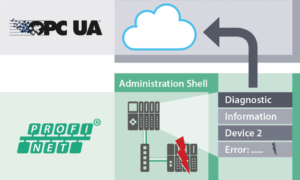At this year’s PI Konferenz in Frankfurt, a user complained that approximately 90% of the data accrued in today’s production process remains untapped. The reasons for this are varied. Many devices produce additional data (e.g., about the condition of the device, runtime, etc.) that are irrelevant for the actual automation task and operation. That’s why these data are not connected through conventional field buses. This is most evident in the process industry, where many 4–20 mA field devices are still in use today that don’t communicate any data apart from the actual process value.
 A further aspect – particularly concerning diagnostics and maintenance data – is that there are no standardized interfaces for these data. Manufacturers have multiple proprietary solutions for presenting this information in their own tools. PROFINET addressed this problem at an early stage and provided standardized interfaces by way of information and maintenance data, diagnostics, and alarms. This enables engineering systems to assess these interfaces independent of the manufacturer. However, other protocols (e.g., OPC UA) are the tool of choice when it comes to connections to IT systems or cloud applications.
A further aspect – particularly concerning diagnostics and maintenance data – is that there are no standardized interfaces for these data. Manufacturers have multiple proprietary solutions for presenting this information in their own tools. PROFINET addressed this problem at an early stage and provided standardized interfaces by way of information and maintenance data, diagnostics, and alarms. This enables engineering systems to assess these interfaces independent of the manufacturer. However, other protocols (e.g., OPC UA) are the tool of choice when it comes to connections to IT systems or cloud applications.
That’s why PROFIBUS & PROFINET International (PI) entered into a partnership with the OPC Foundation to specify the interfaces mentioned above for OPC UA as well. Information models were developed on the basis of specific use cases. For the first two application cases, a companion specification has now been finalized, providing information models for asset management and diagnostics.
This allows users of IT applications to do such things as recognize all devices in a production cell or machine and determine if further devices can be added, exchanged, or updated. This also allows for a target–actual comparison of the various devices’ configuration. Now that the first step of the specification of OPC UA information models for PROFINET has been completed, further use cases will be addressed from the user perspective. One of the next cases to be tackled is the development of an interface for energy measurement data based on PROFIenergy. This will allow PROFINET users to benefit from available data much more easily and to develop new business models as a result.

 Karsten Schneider
Karsten Schneider